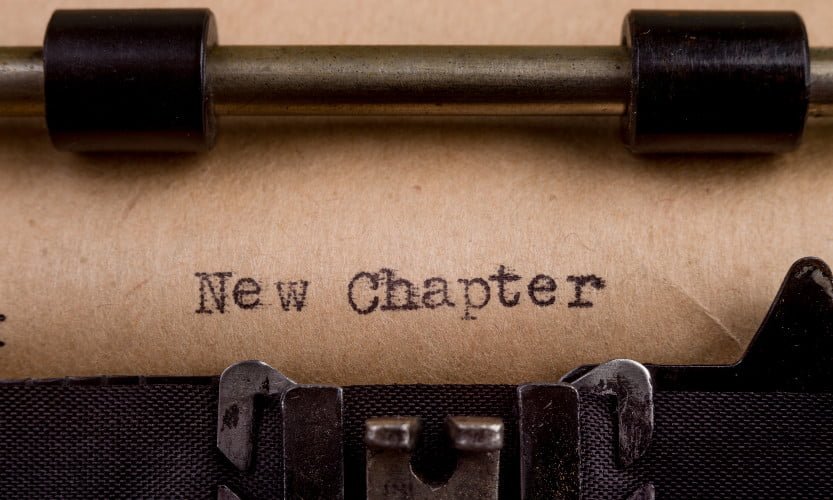Chapter structure may not sound like the sexiest topic, but it has a significant effect on whether readers enjoy your story. As you strive to become a better writer, examining different aspects of your writing, perhaps you’ve wondered: How long should my chapters be? How do I structure my chapters and make them flow?
In this guide, we’ll talk about why chapters exist, and we’ll look at how you can enhance your reader’s experience by carefully considering the context, pacing, content, openings, and titles of your book’s chapters.
To start off, let’s look at a question whose answer might seem obvious: what is a chapter?
What Is A Chapter?
The most simple answer is that a chapter is simply a marked division of a book.
The origin of chapters is unknown, but they appear to have developed around or before 400 AD, alongside the concept of a table of contents. In many early examples, the front of the book would contain a numbered summary of each chapter. The reader could then find the corresponding number in the body of the book.
In reference books, chapters are still used in much the same way. They form part of an overall indexing and organising system that makes the book more useful as a store of information.
However, in novels and narrative non-fiction, book chapters serve a different purpose.
The rest of this guide focuses on chapters in novels and narrative non-fiction. To begin with, let’s clarify the difference between chapters and scenes.

How Chapters Work
In this section, we’ll look at how chapters work, how they differ from scenes, what they’re for, and how chapter lengths are assigned.
Chapters Vs. Scenes
Chapters and scenes are related, as they are both parts of a book, but they are not the same thing:
- A scene is a part of your narrative, where characters experience certain events in a particular time and place.
- A chapter is a division of your book, marked by a number or title.
In some novels, chapters contain one scene each.
More often, each chapter of a book will contain several related scenes. In this case, the scenes are usually divided from one another by whitespace, by a typographic ornament, or using a transition phrase in the text itself—but not by a number or title.
What Are Chapters For?
Unlike a reference book, you typically read a novel from front to back, often across multiple sittings. Chapters in novels support this experience in two ways:
- Chapters mark appropriate “pause points”. These are moments where the reader can safely put down the book and forget those short-term details we normally hold in our heads as we read, like which characters are present, who just spoke, and so on. (A scene break can also function as a pause point within a chapter.)
- Chapter divisions make the story more clear by creating a space when there’s a change in focus, such as a change in viewpoint or location, a jump in time, or a new type of action.
These two purposes often overlap.
Chapter Length
There are no hard rules about length when writing chapters. In addition to being functional, chapters in a novel are part of an author’s storytelling style and can be used in a variety of ways. But here are some guidelines to consider:
- There’s no specific maximum length for a chapter. If a chapter is too long, you’ll probably notice that the pacing is slow, or that the chapter contains too many unrelated scenes. However, a long chapter can be appropriate for a climactic scene, or a passage that’s meant to feel arduous.
- There’s also no specific minimum length for a chapter. Too many chapter breaks can annoy the reader, or come across as precious or grandiose. If a short chapter has the same focus as the chapter before or after, consider merging them and using a scene break instead. However, a short chapter can be appropriate when the action is quick (especially when switching between multiple viewpoints), or when emphasising a specific moment that you don’t want to clutter with details.
- (For more detailed advice about chapter lengths, see our guide How Long Should a Chapter Be?)
- Remember that chapters are not scenes, so not every scene break requires a new chapter.
- When you keep chapter lengths consistent throughout most of your book, you establish a rhythm. You can then break this rhythm at a key moment to create an effect.
Now that we know how chapters work in general, let’s talk about how to structure them.

How To Structure A Chapter
The structure is an important part of how chapters are used, and it can be helpful to plan out your chapters and determine which type of structure works for you.
When To Plan Your Chapters
If you like to plan ahead, or if you like to write from prompts with word counts, you’ll do best by planning your chapters in advance. However, if you find that type of planning too constricting, it’s fine to ignore chapter divisions while you write your first draft. When that draft is complete, you can use your revisions to consider where to insert chapter divisions.
(Now, this isn’t to say you shouldn’t plan at all. See our guide How to Plan a Novel for advice on planning the broad strokes before you write that first draft.)
Structuring A Chapter: A Method For Everyone
Here’s a method anyone can use to structure a chapter. If you like to plan ahead, use these steps while plotting your book. If you prefer to write organically, then organise and revise, use these steps as part of your revisions.
Either way, this method will help you think about how to write a chapter by grouping and linking scenes, and cue you to whether there might be scenes missing that you should add, or superfluous ones you should (re)move.
Keeping in mind that every chapter is both a self-contained experience and also part of the complete story, consider these questions:
- What is the reader’s mindset coming into this chapter?
- How intense was the previous chapter? Do we want to increase, decrease, or maintain that intensity?
- What changed or what did the reader learn in the previous chapter? Do you want to elaborate on that immediately (consequences, added details, reactions), or do you want to switch focus (give the reader time to ponder or let their curiosity simmer)?
- What was the emotional tone of the previous chapter? Do you want to maintain or contrast that?
- What should the reader’s mindset be as they enter the next chapter? How will you set that up?
- Do you want the reader’s mind clear or preoccupied when the next chapter begins?
- What emotional state do you want them in? Will the next chapter have its best impact if the reader enters it excited, demoralised, apprehensive, …?
- What does the next chapter focus on? Can you prime the reader’s interest by planting questions that the next chapter will address? Can you make the next chapter feel fresh by avoiding unnecessary references to what it will focus on (“topic fatigue”)?
- What job does the current chapter need to do?
- What does the reader need to learn, and how are you delivering that information?
- Which events need to happen on-stage, which ones off-stage, and which are flexible?
- If you have a multiple-viewpoint novel, which viewpoints are available to relay this chapter’s events?
- What length is appropriate for this chapter?
As you answer these questions, you’ll get a good idea of which scenes should be included in a chapter and how they should be presented in terms of viewpoint, tone, and focus.
(Note—if you’re not clear on the overall plot of your novel, you’ll need to get that straight first before you worry about making chapters flow smoothly. See our guide How to Plot a Novel for advice and tools for plotting.)
Two Kinds Of Bad Chapters
Pay special attention to fixing two types of bad chapters: chapters where nothing happens, and chapters where things happen but nobody cares. If you have a chapter that’s not working, try these questions:
- What is the most important thing that happens? Is the chapter built to support that event, or does it contain distractions and superfluous material?
- Does this chapter exist solely to let you include a scene that you love? Can the story exist without this chapter? If so, try deleting it.
- Does this chapter exist solely to move characters to new locations or otherwise “get them ready” for future chapters? If so, always delete it. You don’t need to announce location changes to the reader, you can have them happen off-stage and refer back to them with a single sentence. (“Mary touched down at LAX just as furious as when she took off. She’d decided to fly out the moment she learned of Frank’s act of embezzlement.”)
- Is this chapter an infodump? If so, try to delete the entire chapter by diffusing your exposition into earlier chapters. At worst, you’ll tighten it up considerably.
- Does this chapter handle its events in a memorable way? If you have a chapter that is focused and does what it needs to plot-wise, but it just isn’t that interesting, that can be a cue to think up a set-piece or a more original way of handling the action of this chapter.
Sometimes, deeply probing a bad chapter will help you to uncover deeper problems in your story structure. (In other words, maybe the chapter is bad because there’s no good way to tell it.) If a chapter feels bad during your early revisions, be a bloodhound and follow the trail until you’re satisfied.

How To Start A Chapter
Starting a chapter can be daunting in much the same way as starting a book. Luckily, some of the same advice applies.
Below is a process you can use for any genre. As before, use it as a planning tool or a reviewing tool, depending on your writing style.
Starting A Chapter- Reader’s Attention Method
Think of a well-planned tourist attraction: its entrance is carefully planned to focus and guide people to ensure their experience is enjoyable. The start of your chapter can accomplish the same thing using these steps: (1) tell the reader where they are, (2) get their attention, (3) put their focus where you need it, (4) lead them on from there.
To tell the reader where they are, use a chapter title, dateline, or opening sentence to provide them with a mental starting point. You might tell them whose viewpoint they’re in, or where the scene is set, or something that’s just happened. This is the equivalent of the tourist attraction’s “Welcome to …” sign.
To get their attention, don’t think “volume turned to 11” so much as “shiny object”. One technique is to force the reader to activate their mind’s eye by giving them a partial image. Another is to engage their analytical mind by creating an open question. Either way, you’re demanding that their mental resources be focused on the story—if half their brain is still on their grocery list, this will help them forget about it.
Now put their focus where you need it. Do you want the reader to watch a particular character’s movements? Speculating about someone’s intentions? Thinking about a particular problem or mystery? Use the image or open question from the previous step to bring their attention where you need it. For example, if you want their attention on a particular character, your opening image might be of something that character is touching, or of an article of that character’s clothing.
Now you’re ready to lead the reader onward. Let the natural action of your chapter begin to unfold.
Starting A Chapter—Example
Let’s create an example for a crime thriller novel. We’ll say our protagonist has been captured, and we want to set up a tense conversation between him and his captor, followed by an exciting escape sequence. We might try this:
Mojave desert, Monday, 2pm
The pocket-watch was ornate; Civil War most likely. Jesse watched it swing from the brown suit jacket as the barrel chest paced back and forth in front of him, the voice droning on.Gold. Some sort of flowers or vines engraved on it. Diamond stud. Roman numbers on the face.
Jesse looked up. His neck was burning. He hadn’t been able to loosen his wrists at all.
McCallum was looking somewhere out on the horizon. Talking about loyalty and betrayal. Jesse was too dehydrated to focus on the details.
Then McCallum stopped talking, and Jesse realised he could hear the pocket-watch keeping time—a dutiful witness to his final minutes.
Here’s how we developed our chapter opening:
- We tell the reader where they are using a dateline, a common device in thrillers. The phrase “Monday, 2pm” tells us how much time has passed since the previous chapter. The fact that it’s daytime gives us the start of a mental image of the desert.
- Now we get the reader’s attention with an initially vague description of the pocket-watch and its owner. Ornate, but how? And why is the owner above Jesse’s eye level?
- Now we give the reader answers paired with more questions, focusing them on Jesse’s predicament. They realise that Jesse is tied up, kneeling, dehydrated, and apparently in mortal danger. The reader can see that the immediate concern of this chapter will be Jesse’s desire to escape this situation and that McCallum wants a final confrontation.
- Now we’re ready to lead the reader onward to the action of the chapter: words will be exchanged, Jesse will attempt to escape, and the reader will anticipate the outcome.
This is just one way we could have started this chapter. Using the same method, we might instead have started with Jesse waking up in a dark, cramped space; hearing snatches of muffled dialogue; then realising he’s in a car trunk when it’s opened and blinding light streams in. The method is a checklist—your creativity fills in the blanks.
Now that you have a method for writing a chapter opening, let’s look at one final detail: chapter titles.

How To Write Chapter Titles
The first thing to keep in mind about chapter titles is that, unlike a great book title, they’re optional! Plenty of books do without them, so don’t feel obligated to include any if you don’t think it enhances your story.
If you do want to include chapter titles, think about what job they’ll be doing; this will point you toward which format to use.
Chapter Title Ideas
If you want to tease or foreshadow the events of the chapter, you can use your title to describe coming events in an abstract or concrete way. For example:
Chapter 7: In Which Bertie McLannister is Shot, But Survives
Chapter 13: The Showdown at the Mill
Chapter 21: An End to Suffering
If you just want a distinct title so your reader can tell chapters apart, you can pull the title from a memorable piece of dialogue or description. For example:
Chapter 34: I couldn’t forget you if I tried
Chapter 6: The temple, its battered walls defiant
If your novel jumps among multiple viewpoints, you can incorporate the viewpoint character’s name into the title. (Alternately, you can put the viewpoint character’s name in a dateline. This can be a better option if you plan to change viewpoints within the chapter as well.) For example:
Chapter 16: Lucy
Chapter 16: Lucy’s Story
Chapter 12: Jack Carter: The Showdown at the Mill
If time, timing, or location are particularly important, your title can incorporate a date or time. (Again, this information can also be given in a dateline.) For example:
Chapter 3: Mojave Desert, Monday, 2pm
Chapter 3: A dutiful witness—Monday, 2pm
These chapter title examples show some of the most common formats. Other possibilities exist—you can use any format that complements the experience you’re trying to create.
However, be sure to stay consistent. You shouldn’t vary the format of your chapter titles unless you have a good reason, such as two viewpoint characters with different ways of thinking—perhaps one is always acutely aware of the time, the other attuned to their mood.
Crafting Chapters
Using chapters with purpose will make your book (and your writing process) more satisfying.
In this guide, I’ve given you some tools for thinking about the context, purpose, structure, opening, and titles of your chapters. When you’re ready for the next step, one of the best sounding boards for your ideas is speaking with other authors.
Jericho Writers is a global membership group for writers, providing everything you need to get published. Keep up with our news, membership offers, and updates by signing up to our newsletter. For more writing articles, take a look at our blog page.










